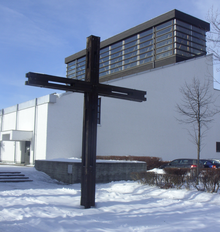Appearance of the Lord (Munich)
The Roman Catholic parish church Apparition of the Lord in the Munich district of Blumenau is a modern church building without a tower and thus also without church bells , which was built in 1969 and 1970. The patronage of the Epiphany refers to the solemn festival of the same name , which is celebrated on January 6th and is popularly known as the Epiphany.
Location and surroundings
The churchyard forms the center of the site. To the south of this is the parish hall , to the west the parsonage with parish office and to the north the parish church . The roofs of the three structures are each aligned so that they slope down towards the churchyard. On the east side, the area opens up to Blumenauer Strasse. There the visitor is greeted by a large wooden cross.
To the west of the church is the parish Catholic kindergarten Epiphany .
history
Shortly after the Blumenau residential complex in the west of Munich was built, the desire for a church of their own arose. In 1965 Helmut Eisele, the chaplain of the neighboring parish Corpus Christi, was commissioned to build the new parish including its own church. In the same year the architect Günter Eisele began planning the church and the parish center. On July 19, 1969, the foundation stone was laid by Auxiliary Bishop Ernst Tewes , and on September 27, 1970, the church was consecrated by Archbishop and Cardinal Julius Döpfner .
In November 2011, the parish apparition of the Lord, together with the neighboring parishes of St. Willibald and Corpus Christi, founded the parish association Salvator mundi , which has been looked after by the Salvatorian Fathers of St. Willibald since then .
architecture
The parish church is a modern rectangular building with a pent roof . Probably the greatest specialty is the roof construction. This consists of wooden beams that seem to hang uselessly from the ceiling. However, these beams are supported on a network of steel cables, which in turn in a ring beam of reinforced concrete is fixed. The altar island on the north side forms the optical center of the church service room. Chairs for the church service are set up around these on three sides. Fixed pews are not available. On the north side, on both sides of the altar island, there are two niches open to the church, in which the weekday chapel is housed on the left and the patronage relief on the right.
Furnishing
The folk altar is a block carved from a block of Bulgarian Danube shell limestone , which rests on a slightly smaller square base. A panel painting in the shape of a cross, painted on oak , hangs above the altar . It was created in 1981 by the painter Werner Persy from Trier . The crucified one is depicted on the side facing the community. He is surrounded by vine leaves and grapes, that is, symbols of the Eucharist . On the back there are four representations that testify to the saving and strengthening appearance of God: the salvation of the Israelites from the Red Sea (above), the salvation of the prophet Jonah (below), the salvation of the three young men from the fire ( Daniel 3, left) and Pentecost (right).
The cube-shaped tabernacle is positioned at the corner of the church interior and the side chapel and can be seen from both sides. It was created in 1970 by Thomas Otto Munz from Niederneuching near Erding . The ambo , baptismal font and Easter candlestick, all of which were made by Fritz Brosig from Grafing , still belong to the original furnishings of the church. It was not until the 2000s that the Way of the Cross , created by Maria Munz-Natterer, and the chandeliers of the Apostles came into the church. In addition, on Epiphany 2007, the relief of the patron saint was inaugurated with a depiction of the adoration of the Magi . It also comes from Maria Munz-Natterer.
The organ was built in 1975 by the Munich company Wilhelm Stöberl .
Web links
Individual evidence
- ↑ a b c d e Architecture and furnishings of the parish church Apparition of the Lord . Online at www.pfarrverband-salvator-mundi.de. Retrieved December 21, 2016.
- ↑ Parish Church Apparition of the Lord . Online at www.pfarrverband-salvator-mundi.de. Retrieved December 21, 2016.
Coordinates: 48 ° 7 ′ 34.7 ″ N , 11 ° 28 ′ 28.9 ″ E
